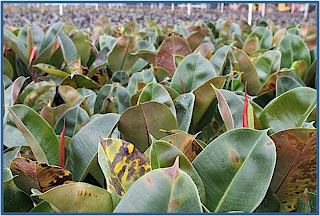Species of Ficus are common tropical foliage plants used for interior decoration and in landscapes throughout warm climates such as South Florida. Ficus species used as foliage plants include F. altissima, F. benjamina, F. binnedijkii, F. elastica, F. lyrata, F. microcarpa, F. pumila, F. retusa, and F. rubiginosa among others . Florida has led the nation in the production of foliage plants, accounting for more than 55% of the national wholesale value since the 1960s (Chen, J., R.J. Henny, and D.B. McConnell. 2002) 

Hot, humid, and rainy conditions (typical summer in South FL) are highly favorable conditions for plant disease. Xanthomonas is a bacterial plant pathogen that thrives under these conditions and is spread very effectively in water, especially windblown rain. Once cells of the bacterium come into contact with the plant they enter through wounds or natural openings such as stomata or hydathodes. Once inside the plant they can move systemically causing a severe blight of the leaves.
Xanthomonas campestris pathovar fici is reported to be the causal agent of bacterial blight affecting species of Ficus. Host studies indicate that several Ficus species and cultivars are susceptible including F. benjamina , F. buxifolia, F. triangularis, F. mexicana, F. maclellandii ‘Alli’, F. retusa ‘California Nitida” and ‘Green Gem’ and F. Grennisland (Chase and Henley 1993)
Symptoms:
On young plants initial symptoms appear as small, water soaked, circular lesions with irregular borders near the leaf margin (Fig 1)
After 7 to 14 days of initial infection, lesions enlarge, coalesce and typically cover large portions of the leaf area (Fig 2)
Premature senescence and leaf drop is common. When young plants (liner stage) become infected the disease can be fatal (Fig 3)
Older plants can also become infected and show a range of symptoms. Spots on the upper surface of leaves are brownish-black with a chlorotic halo (Fig 4) and leaf tissue appears water soaked on the opposite side (Fig 5)

Management:
Be certain to monitor irrigation and avoid watering late in the day or evenings. If using overhead irrigation water in the morning, so that the foliage has time to dry before evening. Allowing the foliage to dry will reduce spread of the bacteria. Using micro jet or drip irrigation minimizes moisture on the foliage and reduces Be sure to surface disinfest all pruning tools. Good sanitation is crucial for managing bacterial pathogens.
As a preventative measure apply one of the following labeled pesticides according to the manufacturer. If copper based fungicides have never been used be certain to test on a small number of plants before applying to the entire crop. Be careful to use appropriate rates of copper compounds, with water at pH 6.0 or 6.5, since copper toxicity symptoms can look similar to those caused by the bacteria.
Current Research:
The current Xanthomonas outbreak on Ficus elastica has negatively affected many tropical foliage nurseries throughout Miami-Dade County. Plant losses are reported to be in the hundreds of thousands, so this is most definitely becoming an economically important disease.
The Palmateer lab is currently conducting research to 1) determine if Xanthomonas isolates from Ficus elastica are different from those previously reported to cause disease on other Ficus species; 2) conduct host range trials to see if other (i.e. Strelitzia spp., Ficus spp., Cordyline sp., Anthurium sp., Syngonium sp., and Dieffenbachia) popular foliage plants are susceptible; 3) evaluate the impact of temperature and light on disease; and 4) conduct bactericide efficacy trials.







No comments:
Post a Comment